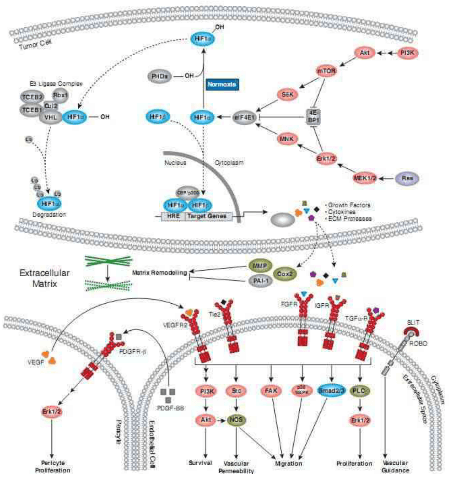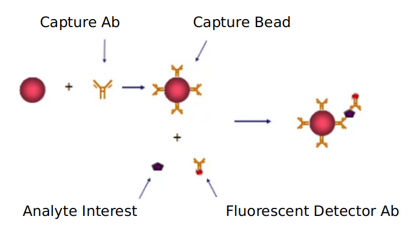Introduction to angiogenesis signaling pathway
Based on Luminex technology platform, Creative Proteomics provides analysis services for key targets of angiogenesis signaling pathway.
 Angiogenesis is defined as the physiological process of forming new blood vessels from pre-existing blood vessels. It is a key process that promotes development, skeletal muscle hypertrophy, menstruation, pregnancy, and wound healing, but can also cause pathological conditions, including neovascular diseases (such as retinopathy), rheumatoid arthritis, psoriasis, AIDS/Kab West Sarcoma and Cancer. Tumorigenesis). Angiogenesis is a complex and highly ordered process that relies on endothelial cells (EC), their associated parietal cells (vascular smooth muscle cells [VSMC] and pericytes) and other cell types (such as immune cells) between and within Extensive signal network.
Angiogenesis is defined as the physiological process of forming new blood vessels from pre-existing blood vessels. It is a key process that promotes development, skeletal muscle hypertrophy, menstruation, pregnancy, and wound healing, but can also cause pathological conditions, including neovascular diseases (such as retinopathy), rheumatoid arthritis, psoriasis, AIDS/Kab West Sarcoma and Cancer. Tumorigenesis). Angiogenesis is a complex and highly ordered process that relies on endothelial cells (EC), their associated parietal cells (vascular smooth muscle cells [VSMC] and pericytes) and other cell types (such as immune cells) between and within Extensive signal network.
The angiogenesis signal pathway is regulated by many complementary and complex signal pathways existing in the human body. Vascular endothelial growth factor (VEGF)-vascular endothelial growth factor receptor (VEGFR), angiopoietin (Ang)-Tie2 axis and D114- The three complex and complementary signaling pathways of Notch can play an important role in regulating angiogenesis.
Vascular endothelial growth factor (VEGF) is a family of proteins required for signaling pathways for angiogenesis. VEGF plays a central regulatory role in the process of angiogenesis and formation, and is a key stimulating factor for angiogenesis.
Pathological and physiological angiogenesis have many similarities in signal events and the resulting changes in cell function and behavior, and therefore may be a new treatment option for fighting diseases. However, a key difference is that pathological vascular development does not stop after sufficient tissue perfusion. This uncontrolled, disorganized, unresolved growth hinders the development of new angiogenesis disruptors.
Our detectable targets:
| AKT | Erk2 | TYK2 | STAT1 | STAT2 | STAT3 |
| PLC | VEGF | JNK | MYD88 | Rac1 | TLR4 |
| Ak2 | IRF3 | MAPK | NAP1 | Rel | TLR9 |
| FAK | BUT | Mda-5 | NFκB | RIG-1 | TRAF3 |
| PI3K | MNK | MEKK1 | p38 | RIP1 | TRAF5 |
| SrC | IRF5 | MEK3 | p38MAPK | SH2 | TRAF6 |
| NOS | IRS1 | MEK6 | p50 | SLP76 | TRAM |
| PAI-1 | IRS2 | MSK1 | TLR3 | Tak1 | TRIF |
| Erk1 | ISGF3 | MSK2 |
Technology platform:
We provide Luminex technology for angiogenesis signaling pathway analysis.
Luminex technology is a multifunctional liquid phase analysis platform developed on the basis of colored microspheres, laser technology, applied fluidics and high-speed digital signal processing technology. The core is to encode polypropylene microspheres or magnetic microspheres with fluorescent dyes. By adjusting the different ratios of the two fluorescent dyes, up to 100 microspheres with different fluorescence spectra can be obtained. Antigen-antibody, enzyme-substrate, ligand-receptor binding reactions and nucleic acid hybridization reactions are performed on microspheres with different fluorescence encoding. Qualitative and quantitative analysis by laser detection of microsphere coding and reporter fluorescence separately.
Angiogenesis signaling pathway is the physiological process of blood vessels forming new blood vessels. It is a key process that promotes development, skeletal muscle hypertrophy, menstruation, pregnancy and wound healing.
In addition to Luminex Multiplex Assay, Enzyme-linked immunosorbent assay (ELISA), Flow cytometry (FACS analysis) technology can also be provided to meet other customer needs.
Advantages of angiogenesis signaling pathway detection:
- High-throughput: Simultaneous analysis of multiple target molecules in the same sample. Theoretically, the detection flux is equal to the number of types of microspheres, that is, up to 100 types.
- Low sample consumption: Because 100 different target molecules can be detected in the same reaction well at the same time, the amount of sample is greatly saved; and because of the small size of the microspheres, as little as 1 puL of samples can be detected.
- Simple and fast operation: Because it is a liquid phase system, the reaction time is greatly shortened, and multiple cytokine detection can be completed within 2 to 3 hours.

Application of our service:
- To study the regulation mechanism of angiogenesis signal pathway in disease
- To study the effect of each virus on angiogenesis signaling pathway
- To study the effects of drugs or therapies on angiogenesis signaling pathways
Creative Proteomics has developed a signal pathway target detection platform. We are not limited to providing angiogenesis signal path detection services, but can also provide other signal path detection services. If you want to detect other targets, please contact us and we will customize the service for you. Look forward to working with you.
References:
- Adams RH, Alitalo K. >Molecular regulation of angiogenesis and lymphangiogenesis. Nat Rev Mol Cell Biol, 2017,8: 464-478.
- Chung AS, Lee J, et al. Targeting the tumor vasculature: insights from physiological angiogenesis. Nat Rev Cancer, 2018, 10, 505-514.
- Fraisl P, Mazzone M, et al. Regulation of angiogenesis by oxygen and metabolism. Dev Cell, 2019, 16, 167-179.



